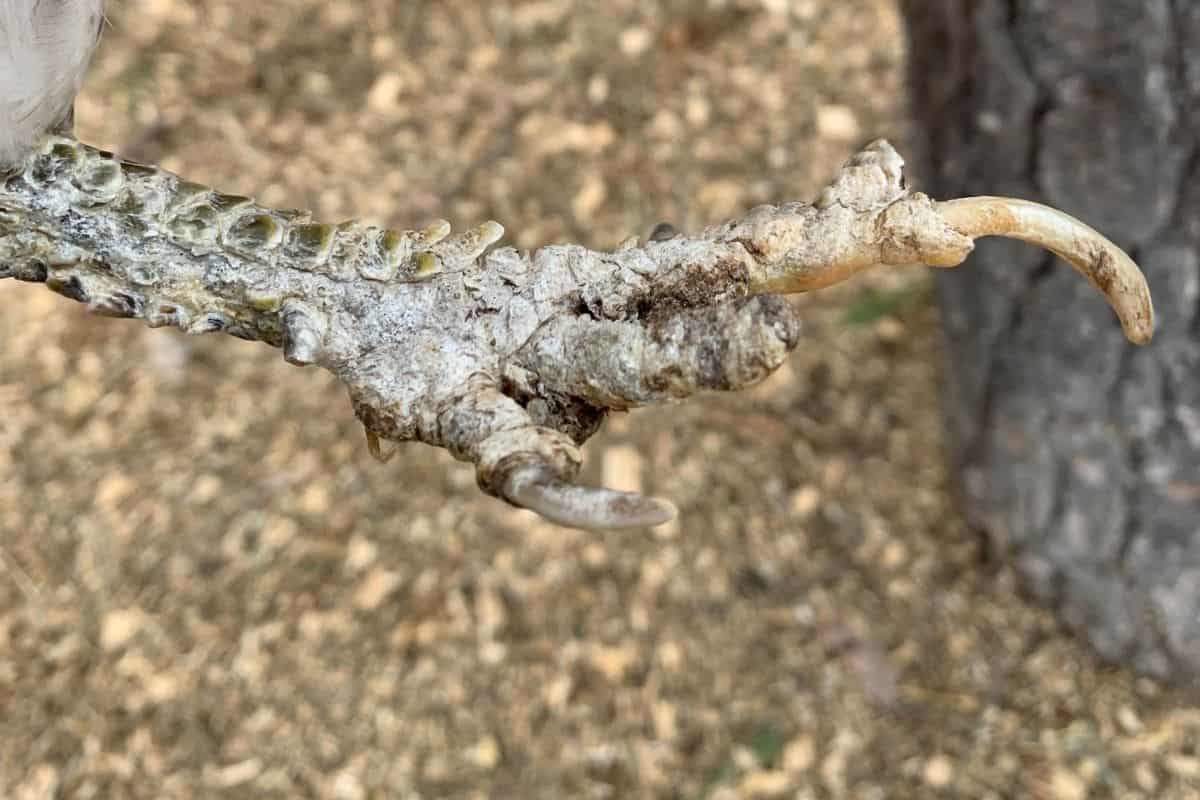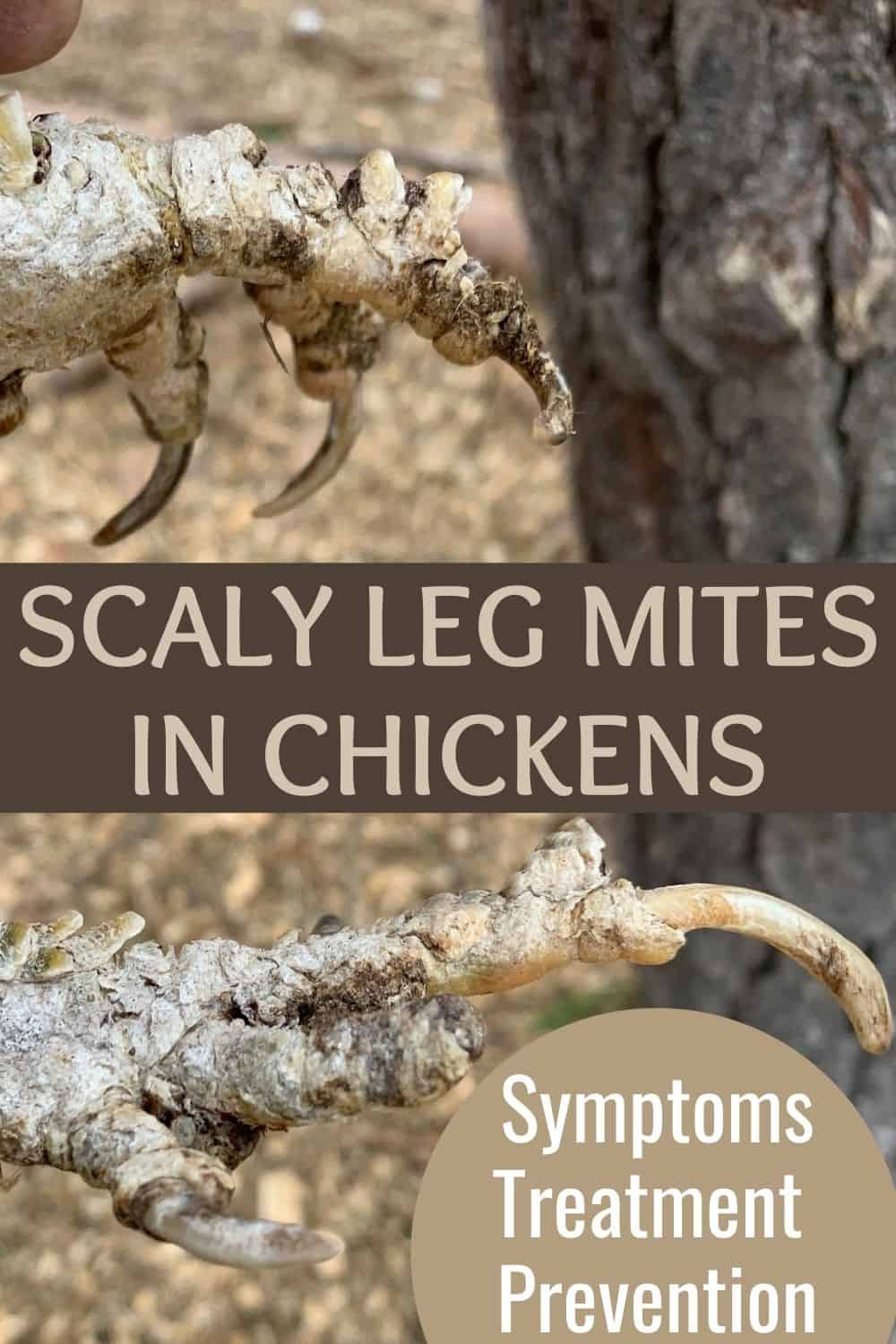The scaly leg mite is a common parasite found in backyard chicken flocks. Let’s discuss the signs, symptoms, treatment, and prevention of scaly leg mites in chickens.

What Are Scaly Leg Mites?
Scaly leg mites (Knemidocoptes mutans) are external, burrowing parasitic mites that live on the legs of chickens. They are round with four legs positioned close to their retractible feeding appendage.
These mites are microscopic in size and cannot be seen with the naked eye. They spend their lives digging tunnels, laying eggs, and feeding on the tissue of the chicken’s legs and feet.
While they are typically found on the legs and feet, there have been reported cases of them infesting the comb and wattles, neck, and sometimes even the beak. The typical life cycle of the scaly leg mite is ten to fourteen days.
How Do Chickens Get Scaly Leg Mites?
Scaly leg mites are initially introduced to the flock through an infected chicken or from wild birds or rodents. They can even be present in the soil waiting for a host to come along.
The scaly leg mite lives its entire life on its host, in this case, the chicken. They are highly contagious and spread from bird to bird through close contact, for example when your chickens are sleeping on the roosting bars at night.
The mites will travel from one infected bird to another. They will also infect chicks while they sleep under the mama hen.
Scaly leg mites can sometimes lay dormant and not begin to burrow and feed until the bird’s immune system has been weakened in some way, for example through an upper respiratory infection or something of that nature. They can be persistent and hard to get rid of.
Other contagious chickens ailments: Common types of worms in chickens
What Are The Signs That My Chicken Has a Scaly Leg Mite Infestation?
The first sign of a scaly leg mite infestation will be a lifting of the chicken’s scales on the legs and feet.
Normally, the chicken’s legs and feet will be smooth and the scales will lay down flat. As the infestation progresses you will see crusting and hardening of the area where the mites are burrowing.
Eventually, the damage caused by the mite’s activity will result in lameness by interfering with the function of the joints and ultimately lead to deformities. Things to look for when diagnosing a scaly leg mite infection are:
- Uneven or lifted scales
- Itching
- Flaking or crusting of the legs and feet
- Damaged leg feathers
- Lameness
- Deformed feet
- Loss of mobility in the joints
In order to get a proper diagnosis of scaly leg mite infestation, a skin scraping can be performed. Often times the clinical signs can be enough to diagnose and begin effective treatment.
How Do I Treat My Chicken For Scaly Leg Mites?
There are a few products on the market targeted for the treatment of scaly leg mites. Scalex and Johnson’s Scaly Lotion to name a couple. These items are typically used on caged birds.
There are also some common household items you can use to successfully treat your chickens.
The best way to kill scaly leg mites is to smother them. This can be done with petroleum jelly, Shea butter, coconut oil, or paraffin oil. First, you will want to wash the bird’s legs and feet with warm soapy water and dry thoroughly. Then apply your treatment.
Whichever product you choose you will need to completely cover your chicken’s legs and feet with it. This should be done on a daily basis until the damaged scales have fallen off and new scales have begun to grow back in. I prefer to use Vaseline as it stays on longer, is less messy, and doesn’t need to be repeated as often as when using oil, typically only once a week. The whole treatment process can take two to three weeks.
Some folks prefer to treat with a chemical dewormer. Ivermectin can be administered orally or topically and is used off-label for chickens. The pour-on should be applied to the base of the bird’s neck, one squirt from a spray bottle should do the trick. Repeat once a week for three weeks.
The injectable Ivermectin should be given orally, .1 mg per pound of body weight. Repeat once a week for three weeks. Since Ivermectin is not labeled for use in chickens you’ll want to observe an egg withdrawal period of 21 days while treating.
You will also need to disinfect your perches as the mites tend to travel along them from bird to bird. You can make a mixture of two parts linseed oil and one part kerosene and brush it onto the perches to kill the mites. If you don’t feel comfortable using that method, VetRX can also be applied with a brush to the roosting bars.
How Do I Prevent My Chickens From Getting Scaly Leg Mites?
The best prevention is good flock management and a solid biosecurity plan. Keeping a closed flock will avoid introducing scaly leg mites into your environment. If you must add to your existing flock, be sure to quarantine all new birds. This will give you time to observe any signs or symptoms of scaly leg mites and treat them before you integrate. A clean, dry environment is also one of the best ways to keep your flock healthy, happy, and parasite free.
Frequently Asked Questions
Can humans get scaly leg mites from their chickens?
No. Scaly leg mites are species-specific parasites. They are not transmittable to humans.
Is Vaseline safe for use on chickens?
Yes, Vaseline is perfectly safe to use externally on your chickens to treat scaly leg mites. Even if they ingest some of it they will be perfectly fine.
How long does it take to get rid of scaly leg mites?
The typical treatment is three weeks. You should see improvement after that. If the infestation is severe there could be some permanent damage such as lameness and deformed toes.
Scaly Leg Mites in Chickens – Conclusion
Scaly leg mites are a serious ailment for your flock. If you see any of the signs (lifted scales, crusty legs, damaged leg feathers, or loss of mobility in the joints, take a closer look at your birds in start treatment immediately. Left untreated, these tiny but dangerous parasites can spread to your entire flock and cause sometimes irreparable damage. Thankfully, it’s not terribly hard to treat if observed early enough.
Learn more about how to raise chickens
Here’s to healthy chickens!


